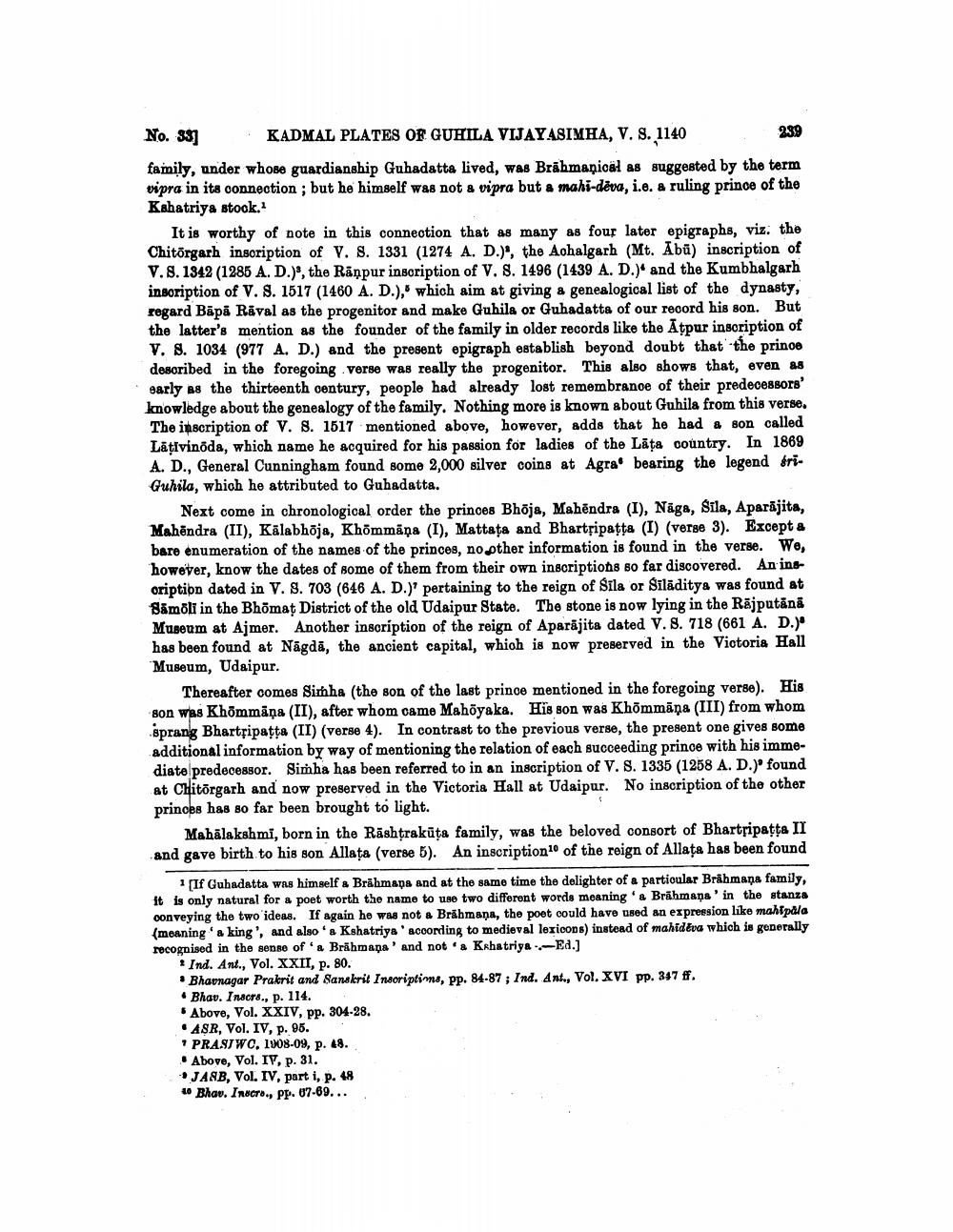________________
239
No. 351
KADMAL PLATES OF GUHILA VIJAYASIMHA, V. S. 1140
family, under whose guardianship Guhadatta lived, was Brahmanical as suggested by the term vipra in its connection; but he himself was not a vipra but a mahi-deva, i.e. a ruling prince of the Kshatriya stock.1
It is worthy of note in this connection that as many as four later epigraphs, viz. the Chitorgarh inscription of V. S. 1331 (1274 A. D.), the Achalgarh (Mt. Abu) inscription of V. S. 1342 (1285 A. D.), the Ranpur inscription of V. S. 1496 (1439 A. D.) and the Kumbhalgarh inscription of V. S. 1517 (1460 A. D.), which aim at giving a genealogical list of the dynasty, regard Bāpā Rāval as the progenitor and make Guhila or Guhadatta of our record his son. But the latter's mention as the founder of the family in older records like the Aṭpur inscription of V. S. 1034 (977 A. D.) and the present epigraph establish beyond doubt that the prince described in the foregoing verse was really the progenitor. This also shows that, even as early as the thirteenth century, people had already lost remembrance of their predecessors' knowledge about the genealogy of the family. Nothing more is known about Guhila from this verse. The inscription of V. S. 1517 mentioned above, however, adds that he had a son called Laṭivinoda, which name he acquired for his passion for ladies of the Lața country. In 1869 A. D., General Cunningham found some 2,000 silver coins at Agra bearing the legend ériGuhila, which he attributed to Guhadatta.
Next come in chronological order the princes Bhoja, Mahendra (I), Naga, Sila, Aparajita, Mahendra (II), Kalabhōja, Khōmmāņa (I), Mattata and Bhartripatta (I) (verse 3). Except a bare enumeration of the names of the princes, no other information is found in the verse. We, however, know the dates of some of them from their own inscriptions so far discovered. An insoription dated in V. S. 703 (646 A. D.)' pertaining to the reign of Sila or Siladitya was found at Sämöll in the Bhōmat District of the old Udaipur State. The stone is now lying in the Rajputana Museum at Ajmer. Another inscription of the reign of Aparajita dated V. S. 718 (661 A. D.) has been found at Nagda, the ancient capital, which is now preserved in the Victoria Hall Museum, Udaipur.
Thereafter comes Simha (the son of the last prince mentioned in the foregoing verse). His son was Khōmmāņa (II), after whom came Mahōyaka. His son was Khōmmāņa (III) from whom sprang Bhartripaṭṭa (II) (verse 4). In contrast to the previous verse, the present one gives some additional information by way of mentioning the relation of each succeeding prince with his immediate predecessor. Simha has been referred to in an inscription of V. S. 1335 (1258 A. D.)' found at Chitorgarh and now preserved in the Victoria Hall at Udaipur. No inscription of the other princes has so far been brought to light.
Mahalakshmi, born in the Rashtrakuta family, was the beloved consort of Bhartripaṭṭa II and gave birth to his son Allata (verse 5). An inscription10 of the reign of Allata has been found
1 [If Guhadatta was himself a Brahmana and at the same time the delighter of a particular Brahmana family, it is only natural for a poet worth the name to use two different words meaning 'a Brahmana' in the stanza conveying the two ideas. If again he was not a Brahmana, the poet could have used an expression like mahipala (meaning a king', and also 'a Kshatriya' according to medieval lexicons) instead of mahideva which is generally recognised in the sense of a Brahmana' and not a Kshatriya-Ed.]
2 Ind. Ant., Vol. XXII, p. 80.
• Bhavnagar Prakrit and Sanskrit Inscriptions, pp. 84-87; Ind. Ant., Vol. XVI pp. 347 ff.
Bhav. Inscrs., p. 114.
Above, Vol. XXIV, pp. 304-28.
ASR, Vol. IV, p. 95.
"PRASIWC, 1908-09, p. 48.
Above, Vol. IV, p. 31. JASB, Vol. IV, part i, p. 48 40 Bhav. Inecro., pp. 67-69...




